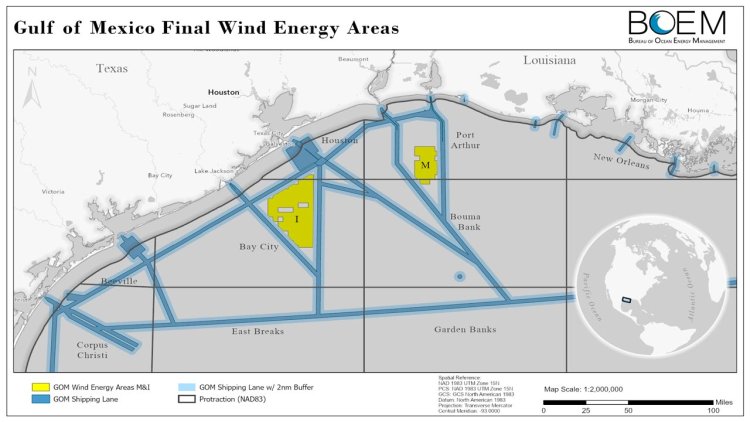As part of the Biden-Harris administration’s goal of deploying 30 gigawatts of offshore wind energy capacity by 2030, the Bureau of Ocean Energy Management (BOEM) has announced it has finalized two Wind Energy Areas (WEAs) in the Gulf of Mexico, with the potential to produce enough clean wind energy to power nearly 3 million homes.
The first WEA is located approximately 24 nautical miles (nm) off the coast of Galveston, TX. The area totals 508,265 acres and has the potential to power 2.1 million homes. The second WEA is located approximately 56 nm off the coast of Lake Charles, LA. The area totals 174,275 acres and has the potential to power over 740,000 homes.
Under President Biden’s leadership, the administration has approved the nation’s first large-scale offshore wind projects, held record-breaking lease sales, and ushered in billions of dollars in private investment. This growing industry will provide Americans with cleaner and cheaper energy, create thousands of good-paying jobs, and invest billions in new American energy supply chains, manufacturing, shipbuilding and servicing.

BOEM uses its renewable energy competitive leasing process to identify the offshore locations that appear most suitable for development, taking into consideration potential impacts to resources and ocean users. BOEM collaborated with the National Oceanic and Atmospheric Administration to build an ocean model that analyzed the entire Gulf of Mexico ecosystem to find areas that have the least conflict with other uses and the lowest environmental impact.
BOEM Director Amanda Lefton said:
“These two wind energy areas represent exciting progress toward having the first offshore wind lease sale in the Gulf of Mexico, where there is a mature industry base and the know how to advance energy development in the OCS. The Region can play a central role in our nation’s clean energy transition to support good paying jobs, fight climate change. BOEM will continue to work with the coastal states and communities as we advance our work and do so in a manner that seeks to avoid or minimize conflicts with other ocean uses and marine life in the Gulf of Mexico.”



